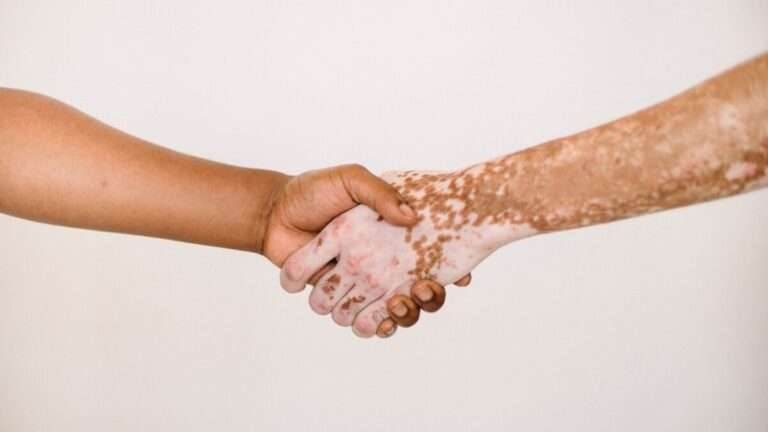Vitiligo is a chronic skin condition that causes the loss of pigment in patches of skin, resulting in white spots or patches. This makes coping with vitiligo a challenge. Vitiligo affects all races and genders equally and is estimated to affect up to 2% of the population worldwide. While there is no known cure for vitiligo, there are treatments available to help manage its symptoms and improve quality of life. This article will discuss coping strategies and support for those living with vitiligo, including how to cope with the physical effects, psychological effects, and social implications of this condition.
What Is Vitiligo?
Vitiligo is an autoimmune disorder that causes a loss of pigment in patches on the skin due to the destruction of melanocytes (the cells responsible for producing melanin). It can affect any part of the body but most commonly appears on areas exposed to suns such as hands, feet, arms, face, or lips. The exact cause remains unknown but it may be related to genetic factors or environmental triggers such as stress or exposure to certain chemicals. The condition can start at any age but usually begins before age 20.
How Can I Cope With Physical Effects?
The physical effects associated with vitiligo can be difficult to cope with due to its visible nature. however, there are several strategies that may help:
Sun protection:
Wear sunscreen every day (SPF 30+) when outdoors and cover up exposed areas with clothing or hats when possible; use sun-protective clothing if needed; avoid tanning beds/booths altogether.
Skin camouflage:
Use makeup specifically designed for covering up vitiligo spots; look into prescription creams/ointments from your doctor which may help reduce visibility.
Moisturizing:
Keep affected areas well moisturized using a gentle lotion twice daily.
Vitamins/supplements:
Talk with your doctor about taking vitamins/supplements which may help reduce inflammation caused by vitiligo.
Laser therapy:
Ask your doctor about laser therapy which can be used in some cases as an alternative treatment option.
Why Is Psychological Support Important?
Living with a chronic condition like vitiligo can have psychological impacts such as low self-esteem due to changes in appearance or feelings of isolation from peers who don’t understand what you’re going through. It’s important for those living with this condition not only physically manage their symptoms but also seek out emotional support from friends, family members or mental health professionals who understand what they’re going through and provide them with coping skills tailored specifically towards their individual needs. Here are some tips on how you can find emotional support if needed:
Reach out online
There are many online communities dedicated specifically towards helping people living with chronic conditions like vitiligo connect virtually so they don’t feel alone during tough times.
Join Local Support Groups
Look into local organizations dedicated to providing emotional support for those living with chronic conditions like vitiligo so you have access to face-to-face interactions when needed.
Talk it out
Don’t hesitate to talk openly about your experiences dealing with the effects associated with the condition, whether it be with family members, close friends, or even strangers online who understand what you’re going through.
What Are the Social Implications of Living with Vitiligo?
Living with Vitiligo has been shown to have social implications beyond just physical ones, such as social anxiety due to fear of judgment from others and feelings of isolation due to a lack of understanding from peers about the condition itself.
These issues can be difficult to properly address, but fortunately, there are several strategies that might help individuals cope better with these emotional impacts, including seeking out peer support through online communities dedicated to those living with the condition, attending local events hosted by organizations focused on providing emotional support to those living with Vitiligo, and talking openly about how you’re dealing with symptoms both physically and emotionally. This type of open communication can be helpful in dealing with social anxieties associated with the condition.
In conclusion, Living with vitiligo isn’t easy, but thankfully there are several strategies that can help individuals manage both the physical and psychological effects associated with the condition more effectively. These include protecting affected areas from sunlight, using makeup and skin camouflage, moisturizing, taking vitamins and supplements, and exploring alternative treatment options like laser therapy. Additionally, seeking out peer support through online communities dedicated to those living with the condition, attending local events hosted by organizations focused on providing emotional support to those living with vitiligo, and talking openly about how you are dealing with the symptoms both physically and emotionally can also prove beneficial in dealing with the social anxieties associated with the condition.
Sources:
- – American Academy of Dermatology (AAD) https://www.aad.org/conditions/skin-conditions/types-of-skin-conditions/what-is-vitiligo
- – National Institute of Arthritis and Musculoskeletal and Skin Diseases (NIAMS) https://www.niams.nih.gov/health-topics/what-is-vitiligo
- – WebMD https://www.webmd.com/skin-problems-and-treatments/scalp-and-skin-diseases/coping-with-vitiligo

